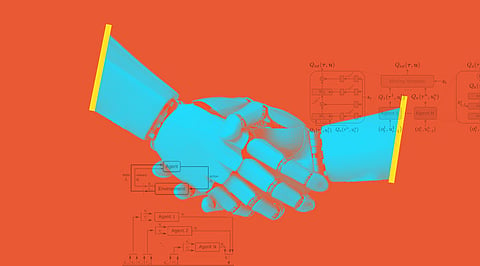

University of Illinois Urbana-Champaign researchers have developed a method to train multiple agents such as robots or drones to work together using multi-agent reinforcement learning (MARL), a type of artificial intelligence. They started with this more difficult challenge. Multi-agent systems can be used to address problems in a variety of domains, including robotics, distributed control, telecommunications, and economics. Reinforcement learning an agent learns to maximize some reward through trial-and-error exploration of its environment, is a hot topic in artificial intelligence.
Multi-agent reinforcement learning is the study of numerous artificial intelligence agents cohabitating in an environment, often collaborating toward some end goal. It deals with having only one actor in the environment. Several MARL algorithms are applied to an illustrative example involving the coordinated transportation of an object by two cooperative robots. It is the study of numerous AI agents cohabitating in an environment, often collaborating toward some end goal. It's not so much the robot chose to do something wrong, just something that isn't useful to the end goal.
The Multi-agent reinforcement learning algorithms can also identify when an agent or robot is doing something that doesn't contribute to the goal. Researchers tested their algorithms using simulated games like Capture the Flag and StarCraft, a popular computer game. This type of algorithm applies to many real-life situations, such as military surveillance, robots working together in a warehouse, traffic signal control, autonomous vehicles coordinating deliveries, or controlling an electric power grid. This scenario is much more complex and a harder problem because it's not clear what can be done by one agent versus another agent.
The described multi-agent algorithms are compared in terms of the most important characteristics for multi-agent reinforcement learning applications namely, non-stationarity, scalability, and observability. Robotics involves manipulating objects in the real world. This creates the ability to manipulate the real world using a combination of machine learning and robotics. Researchers apply the algorithm to several tasks that require the collaboration of multiple drones in a physics-based reinforcement learning environment. Their approach achieves a stable policy network update and similarity in reward signal development for an increasing number of agents.
The research team used machine learning to accomplish a task together over time by creating a utility function that tells the agent when it is doing something useful or good for the team. They developed an ML technique that allows us to identify when an individual agent contributes to the global team objective. Multi-agent systems are not just a research method, they can be used to model many complex problems of today's society, the work was recently presented to the AI community at the Autonomous Agents and Multi-Agent Systems peer-reviewed conference.
Join our WhatsApp Channel to get the latest news, exclusives and videos on WhatsApp
_____________
Disclaimer: Analytics Insight does not provide financial advice or guidance. Also note that the cryptocurrencies mentioned/listed on the website could potentially be scams, i.e. designed to induce you to invest financial resources that may be lost forever and not be recoverable once investments are made. You are responsible for conducting your own research (DYOR) before making any investments. Read more here.
